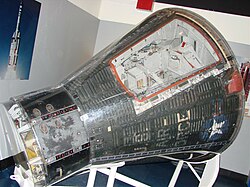 The atmospheric re-entry of Gemini 2 viewed through a pilot's window | |
| Mission type | Flight test |
|---|---|
| Operator | NASA [1] |
| Mission duration | 18 minutes, 14 seconds |
| Range | 3,422.4 km (2,127 mi; 1,848 nmi) |
| Apogee | 171.1 km (106 mi; 92 nmi) |
| Spacecraft properties | |
| Spacecraft | Gemini SC2 |
| Manufacturer | McDonnell |
| Start of mission | |
| Launch date | January 19, 1965, 14:04:00 UTC (9:04 am EST) |
| Rocket | Titan II GLV,s/n 62-12557 |
| Launch site | Cape Kennedy, LC-19 |
| End of mission | |
| Recovered by | USS Lake Champlain |
| Landing date | January 19, 1965, 14:22:14 UTC (9:22:14 am EST) |
| Landing site | Atlantic Ocean ( 16°36′N49°46′W / 16.600°N 49.767°W ) |
Gemini 2 (Gemini-Titan 2; GT-2) [2] was the second spaceflight of the American human spaceflight program Project Gemini, and was launched and recovered on January 19, 1965. Gemini 2, like Gemini 1, was an uncrewed mission intended as a test flight of the Gemini spacecraft. Unlike Gemini 1, which was placed into orbit, Gemini 2 made a suborbital flight, primarily intended to test the spacecraft's heat shield. It was launched on a Titan II GLV rocket. The spacecraft used for the Gemini 2 mission was later refurbished into the Gemini B configuration, and was subsequently launched on another suborbital flight, along with OPS 0855, as a test for the US Air Force Manned Orbital Laboratory. Gemini spacecraft no. 2 was the first craft to make more than one spaceflight since the X-15, and the only one until a Soviet VA spacecraft was reused in 1978. Gemini Spacecraft no. 2 would remain the only American spacecraft to be reused since the X-15 until Space Shuttle Columbia flew its second mission in 1981; it would also be the only American space capsule to be reused until Crew Dragon Endeavour was launched a second time in 2021.





